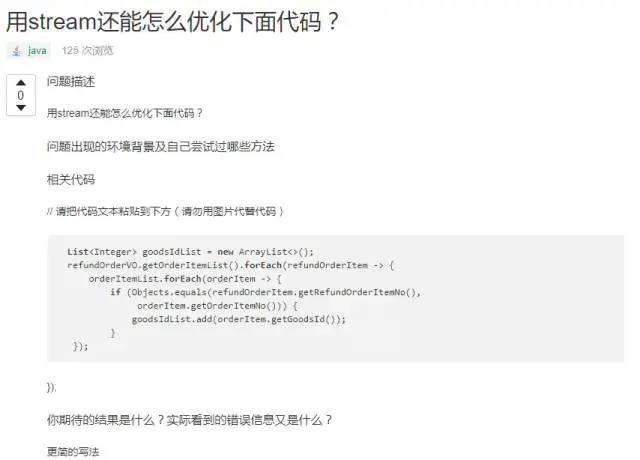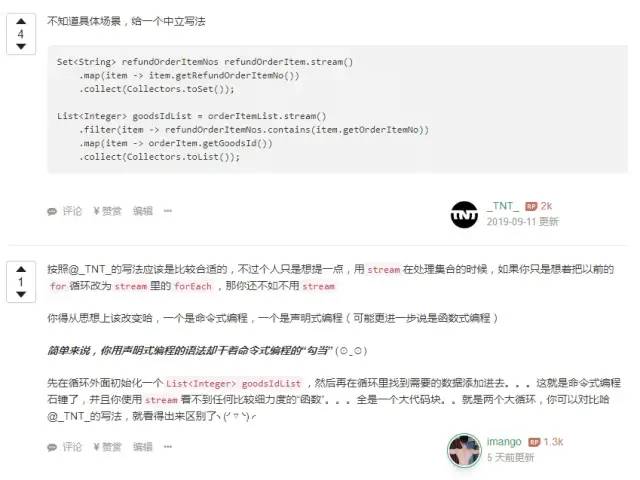使用 Stream API 高逼格优化 Java 代码!
点击上方“码农突围”,马上关注 这里是码农充电第一站,回复“666”,获取一份专属大礼包 真爱,请设置“星标”或点个“在看

使用Stream API优化代码
Java8的新特性主要是Lambda表达式和流,当流和Lambda表达式结合起来一起使用时,因为流申明式处理数据集合的特点,可以让代码变得简洁易读
放大招,流如何简化代码
筛选出卡路里小于400的菜肴 对筛选出的菜肴进行一个排序 获取排序后菜肴的名字
菜肴:Dish.java
public class Dish {
private String name;
private boolean vegetarian;
private int calories;
private Type type;
// getter and setter
}
Java8以前的实现方式
private List<String> beforeJava7(List<Dish> dishList) {
List<Dish> lowCaloricDishes = new ArrayList<>();
//1.筛选出卡路里小于400的菜肴
for (Dish dish : dishList) {
if (dish.getCalories() < 400) {
lowCaloricDishes.add(dish);
}
}
//2.对筛选出的菜肴进行排序
Collections.sort(lowCaloricDishes, new Comparator<Dish>() {
@Override
public int compare(Dish o1, Dish o2) {
return Integer.compare(o1.getCalories(), o2.getCalories());
}
});
//3.获取排序后菜肴的名字
List<String> lowCaloricDishesName = new ArrayList<>();
for (Dish d : lowCaloricDishes) {
lowCaloricDishesName.add(d.getName());
}
return lowCaloricDishesName;
}
Java8之后的实现方式
private List<String> afterJava8(List<Dish> dishList) {
return dishList.stream()
.filter(d -> d.getCalories() < 400) //筛选出卡路里小于400的菜肴
.sorted(comparing(Dish::getCalories)) //根据卡路里进行排序
.map(Dish::getName) //提取菜肴名称
.collect(Collectors.toList()); //转换为List
}
24代码实现的功能现在只需5行就可以完成了 不错!基于Springboot 2.0 + LayUI开发的物流管理系统(已开源)
不错!基于Springboot 2.0 + LayUI开发的物流管理系统(已开源)对数据库查询到的菜肴根据菜肴种类进行分类,返回一个 Map<Type, List<Dish>>的结果
Java8以前的实现方式
private static Map<Type, List<Dish>> beforeJdk8(List<Dish> dishList) {
Map<Type, List<Dish>> result = new HashMap<>();
for (Dish dish : dishList) {
//不存在则初始化
if (result.get(dish.getType())==null) {
List<Dish> dishes = new ArrayList<>();
dishes.add(dish);
result.put(dish.getType(), dishes);
} else {
//存在则追加
result.get(dish.getType()).add(dish);
}
}
return result;
}
Java8以后的实现方式
private static Map<Type, List<Dish>> afterJdk8(List<Dish> dishList) {
return dishList.stream().collect(groupingBy(Dish::getType));
}
Stream API牛批 看到流的强大功能了吧,接下来将详细介绍流 魔都小伙伴们最近要注意的两件事!
魔都小伙伴们最近要注意的两件事!什么是流
如何生成流
通过集合生成,应用中最常用的一种
List<Integer> integerList = Arrays.asList(1, 2, 3, 4, 5);
Stream<Integer> stream = integerList.stream();
stream方法生成流通过数组生成
int[] intArr = new int[]{1, 2, 3, 4, 5};
IntStream stream = Arrays.stream(intArr);
Arrays.stream方法生成流,并且该方法生成的流是数值流【即IntStream】而不是Stream<Integer>。补充一点使用数值流可以避免计算过程中拆箱装箱,提高性能。Stream API提供了mapToInt、mapToDouble、mapToLong三种方式将对象流【即Stream<T>】转换成对应的数值流,同时提供了boxed方法将数值流转换为对象流通过值生成
Stream<Integer> stream = Stream.of(1, 2, 3, 4, 5);
Stream的of方法生成流,通过Stream的empty方法可以生成一个空流通过文件生成
Stream<String> lines = Files.lines(Paths.get("data.txt"), Charset.defaultCharset())
Files.line方法得到一个流,并且得到的每个流是给定文件中的一行通过函数生成 提供了
iterate
generate
iterator
Stream<Integer> stream = Stream.iterate(0, n -> n + 2).limit(5);
iterate
iterator
limit
generator
Stream<Double> stream = Stream.generate(Math::random).limit(5);
generate
Supplier<T>
generate
limit
流的操作类型
中间操作 一个流可以后面跟随零个或多个中间操作。其目的主要是打开流,做出某种程度的数据映射/过滤,然后返回一个新的流,交给下一个操作使用。这类操作都是惰性化的,仅仅调用到这类方法,并没有真正开始流的遍历,真正的遍历需等到终端操作时,常见的中间操作有下面即将介绍的 filter、map等终端操作 一个流有且只能有一个终端操作,当这个操作执行后,流就被关闭了,无法再被操作,因此一个流只能被遍历一次,若想在遍历需要通过源数据在生成流。终端操作的执行,才会真正开始流的遍历。如下面即将介绍的 count、collect等
流使用
中间操作
filter筛选
List<Integer> integerList = Arrays.asList(1, 1, 2, 3, 4, 5);
Stream<Integer> stream = integerList.stream().filter(i -> i > 3);
filter方法进行条件筛选,filter的方法参数为一个条件distinct去除重复元素
List<Integer> integerList = Arrays.asList(1, 1, 2, 3, 4, 5);
Stream<Integer> stream = integerList.stream().distinct();
distinct方法快速去除重复的元素limit返回指定流个数
List<Integer> integerList = Arrays.asList(1, 1, 2, 3, 4, 5);
Stream<Integer> stream = integerList.stream().limit(3);
limit方法指定返回流的个数,limit的参数值必须>=0,否则将会抛出异常skip跳过流中的元素
List<Integer> integerList = Arrays.asList(1, 1, 2, 3, 4, 5);
Stream<Integer> stream = integerList.stream().skip(2);
skip方法跳过流中的元素,上述例子跳过前两个元素,所以打印结果为2,3,4,5,skip的参数值必须>=0,否则将会抛出异常map流映射
List<String> stringList = Arrays.asList("Java 8", "Lambdas", "In", "Action");
Stream<Integer> stream = stringList.stream().map(String::length);
map方法可以完成映射,该例子完成中String -> Integer的映射,之前上面的例子通过map方法完成了Dish->String的映射flatMap流转换
List<String> wordList = Arrays.asList("Hello", "World");
List<String> strList = wordList.stream()
.map(w -> w.split(" "))
.flatMap(Arrays::stream)
.distinct()
.collect(Collectors.toList());
map(w -> w.split(" "))的返回值为Stream<String[]>,我们想获取Stream<String>,可以通过flatMap方法完成Stream<String[]> ->Stream<String>的转换元素匹配
allMatch匹配所有
List<Integer> integerList = Arrays.asList(1, 2, 3, 4, 5);
if (integerList.stream().allMatch(i -> i > 3)) {
System.out.println("值都大于3");
}
allMatch方法实现anyMatch匹配其中一个
List<Integer> integerList = Arrays.asList(1, 2, 3, 4, 5);
if (integerList.stream().anyMatch(i -> i > 3)) {
System.out.println("存在大于3的值");
}
for (Integer i : integerList) {
if (i > 3) {
System.out.println("存在大于3的值");
break;
}
}
java8中通过anyMatch方法实现这个功能noneMatch全部不匹配
List<Integer> integerList = Arrays.asList(1, 2, 3, 4, 5);
if (integerList.stream().noneMatch(i -> i > 3)) {
System.out.println("值都小于3");
}
noneMatch
终端操作
统计流中元素个数
通过count
List<Integer> integerList = Arrays.asList(1, 2, 3, 4, 5);
Long result = integerList.stream().count();
count方法统计出流中元素个数通过counting
List<Integer> integerList = Arrays.asList(1, 2, 3, 4, 5);
Long result = integerList.stream().collect(counting());
collect联合使用的时候特别有用查找
findFirst查找第一个
List<Integer> integerList = Arrays.asList(1, 2, 3, 4, 5);
Optional<Integer> result = integerList.stream().filter(i -> i > 3).findFirst();
findFirst方法查找到第一个大于三的元素并打印findAny随机查找一个
List<Integer> integerList = Arrays.asList(1, 2, 3, 4, 5);
Optional<Integer> result = integerList.stream().filter(i -> i > 3).findAny();
findAny方法查找到其中一个大于三的元素并打印,因为内部进行优化的原因,当找到第一个满足大于三的元素时就结束,该方法结果和findFirst方法结果一样。提供findAny方法是为了更好的利用并行流,findFirst方法在并行上限制更多【本篇文章将不介绍并行流】reduce将流中的元素组合起来
jdk8之前
int sum = 0;
for (int i : integerList) {
sum += i;
}
jdk8之后通过reduce进行处理
int sum = integerList.stream().reduce(0, (a, b) -> (a + b));
int sum = integerList.stream().reduce(0, Integer::sum);
reduce接受两个参数,一个初始值这里是0,一个BinaryOperator<T> accumulator 来将两个元素结合起来产生一个新值, 另外reduce方法还有一个没有初始化值的重载方法获取流中最小最大值
通过min/max获取最小最大值
Optional<Integer> min = menu.stream().map(Dish::getCalories).min(Integer::compareTo);
Optional<Integer> max = menu.stream().map(Dish::getCalories).max(Integer::compareTo);
OptionalInt min = menu.stream().mapToInt(Dish::getCalories).min();
OptionalInt max = menu.stream().mapToInt(Dish::getCalories).max();
min
max
Comparator<? super T> comparator
通过minBy/maxBy获取最小最大值
Optional<Integer> min = menu.stream().map(Dish::getCalories).collect(minBy(Integer::compareTo));
Optional<Integer> max = menu.stream().map(Dish::getCalories).collect(maxBy(Integer::compareTo));
minBy
maxBy
Comparator<? super T> comparator
通过reduce获取最小最大值
Optional<Integer> min = menu.stream().map(Dish::getCalories).reduce(Integer::min);
Optional<Integer> max = menu.stream().map(Dish::getCalories).reduce(Integer::max);
求和
通过summingInt
int sum = menu.stream().collect(summingInt(Dish::getCalories));
double
long
summingDouble
summingLong
通过reduce
int sum = menu.stream().map(Dish::getCalories).reduce(0, Integer::sum);
通过sum
int sum = menu.stream().mapToInt(Dish::getCalories).sum();
collect、reduce、min/max/sum方法,推荐使用min、max、sum方法。因为它最简洁易读,同时通过mapToInt将对象流转换为数值流,避免了装箱和拆箱操作通过averagingInt求平均值
double average = menu.stream().collect(averagingInt(Dish::getCalories));
double、long,则通过averagingDouble、averagingLong方法进行求平均通过summarizingInt同时求总和、平均值、最大值、最小值
IntSummaryStatistics intSummaryStatistics = menu.stream().collect(summarizingInt(Dish::getCalories));
double average = intSummaryStatistics.getAverage(); //获取平均值
int min = intSummaryStatistics.getMin(); //获取最小值
int max = intSummaryStatistics.getMax(); //获取最大值
long sum = intSummaryStatistics.getSum(); //获取总和
double、long,则通过summarizingDouble、summarizingLong方法通过foreach进行元素遍历
List<Integer> integerList = Arrays.asList(1, 2, 3, 4, 5);
integerList.stream().forEach(System.out::println);
for (int i : integerList) {
System.out.println(i);
}
返回集合
List<String> strings = menu.stream().map(Dish::getName).collect(toList());
Set<String> sets = menu.stream().map(Dish::getName).collect(toSet());
List<String> stringList = new ArrayList<>();
Set<String> stringSet = new HashSet<>();
for (Dish dish : menu) {
stringList.add(dish.getName());
stringSet.add(dish.getName());
}
通过joining拼接流中的元素
String result = menu.stream().map(Dish::getName).collect(Collectors.joining(", "));
map方法进行映射处理拼接的toString方法返回的字符串,joining的方法参数为元素的分界符,如果不指定生成的字符串将是一串的,可读性不强进阶通过groupingBy进行分组
Map<Type, List<Dish>> result = dishList.stream().collect(groupingBy(Dish::getType));
collect方法中传入groupingBy进行分组,其中groupingBy的方法参数为分类函数。还可以通过嵌套使用groupingBy进行多级分类Map<Type, List<Dish>> result = menu.stream().collect(groupingBy(Dish::getType,
groupingBy(dish -> {
if (dish.getCalories() <= 400) return CaloricLevel.DIET;
else if (dish.getCalories() <= 700) return CaloricLevel.NORMAL;
else return CaloricLevel.FAT;
})));
进阶通过partitioningBy进行分区
Map<Boolean, List<Dish>> result = menu.stream().collect(partitioningBy(Dish :: isVegetarian))
Map<Boolean, List<Dish>> result = menu.stream().collect(groupingBy(Dish :: isVegetarian))
List<Integer> integerList = Arrays.asList(1, 2, 3, 4, 5);
Map<Boolean, List<Integer>> result = integerList.stream().collect(partitioningBy(i -> i < 3));
总结
Stream API可以简化代码,同时提高了代码可读性,赶紧在项目里用起来。讲道理在没学Stream API之前,谁要是给我在应用里写很多Lambda,Stream API,飞起就想给他一脚。我想,我现在可能爱上他了【嘻嘻】。同时使用的时候注意不要将声明式和命令式编程混合使用,前几天刷segment刷到一条:
imango老哥说的很对,别用声明式编程的语法干命令式编程的勾
- END - 最近热文
• 如果把14亿中国人都拉到一个微信群。。。 • 再见 Win10!下一代操作系统要来了! • 女友回老家了!没吊事,手把手带你搭建一台服务器! • 尼玛,Github上最邪恶的开源项目了!未满18或者女孩子勿进哦~
评论
